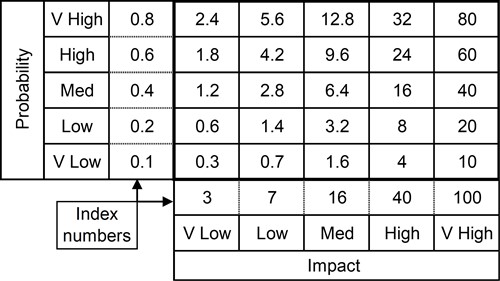A brief guide
Practical Project Risk Management
SERIES ARTICLE
By Martin Hopkinson
United Kingdom
Purpose
Rank a list of risks in an approximate order of their significance.
A Summary of the Technique
The Probability-Impact Matrix (PIM) is based on a simplistic approach to expected value i.e. that the significance of a risk is proportional to its Probability x Impact and that these attributes can be estimated as having single values or values that fit within pre-defined bands.
 The matrix is formed by developing a pair of banded scales, one for probability and the other for impact. Typically, there are five bands per scale.
The matrix is formed by developing a pair of banded scales, one for probability and the other for impact. Typically, there are five bands per scale.
The band boundary values are usually defined in a risk classification criteria table (See separate Guidance Sheet to be published in March 2023)
Index numbers are developed to represent the relative significance of the bands. For example, in the above matrix, High probability risks are treated as being six times as significant as Very Low probability risks with an equivalent impact. These index numbers are multiplied to obtain risk scores – a proxy for significance that can be used for risk prioritization purposes.
Risks are then mapped to the matrix by using their probability and impact estimates and ranked in descending order of risk score. Risks with the same score are ranked equally. If a risk has impact estimates for more than one type of consequence e.g. time, cost and product impact, the worst case impact banding is used for mapping purposes.
Handling Threats and Opportunities
Opportunities might be identified and described as being positive risk events – benefits to the project outcome that might occur. A mirror-imaged extension of the Threats PIM, as shown in the example below, can be used to produce a PIM that handles both threats and opportunities.

Limitations of the PIM
Although the PIM is in widespread use as a project risk assessment technique, it has numerous limitations that should be understood and recognized. Some of the most important are:
More…
To read entire article, click here
Editor’s note: This series of articles is by Martin Hopkinson, author of the books “The Project Risk Maturity Model” and “Net Present Value and Risk Modelling for Projects” and contributing author for Association for Project Management (APM) guides such as Directing Change and Sponsoring Change. These articles are based on a set of short risk management guides previously available on his company website, now retired. For an Introduction and context for this series, click here. Learn more about Martin Hopkinson in his author profile below.
How to cite this paper: Hopkinson, M. (2023). Probability-Impact Matrices: A brief guide, Practical Project Risk Management series, PM World Journal, Vol. XII, Issue II, February. Available online at https://pmworldlibrary.net/wp-content/uploads/2023/02/pmwj126-Feb2023-Hopkinson-Probability-Impact-Matrix-risk-management-article.pdf
About the Author

Martin Hopkinson
United Kingdom
![]()
Martin Hopkinson, recently retired as the Director of Risk Management Capability Limited in the UK, and has 30 years’ experience as a project manager and project risk management consultant. His experience has been gained across a wide variety of industries and engineering disciplines and includes multibillion-pound projects and programmes. He was the lead author on Tools and Techniques for the Association for Project Management’s (APM) guide to risk management (The PRAM Guide) and led the group that produced the APM guide Prioritising Project Risks.
Martin’s first book, The Project Risk Maturity Model, concerns the risk management process. His contributions to Association for Project Management (APM) guides such as Directing Change and Sponsoring Change reflect his belief in the importance of project governance and business case development.
In his second book Net Present Value and Risk Modelling for Projects he brought these subjects together by showing how NPV and risk modelling techniques can be used to optimise projects and support project approval decisions. (To learn more about the book, click here.)
To view other works by Martin Hopkinson, visit his author showcase in the PM World Library at https://pmworldlibrary.net/authors/martin-hopkinson/









